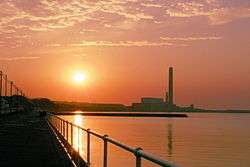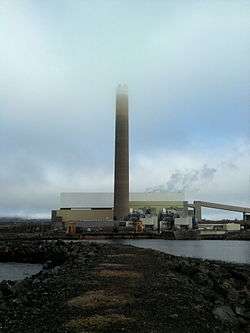Kilroot
Kilroot (from Irish Cill Ruaidh, meaning 'church of the redhead'[1]) is a townland, population centre and civil parish in County Antrim, Northern Ireland. It lies to the east of Eden, on the outskirts of Carrickfergus on the northern shore of Belfast Lough. It is within the Mid and East Antrim Bourgh council area.
Kilroot | |
|---|---|
| Irish transcription(s) | |
| • Derivation: | Cill Ruaidh |
| • Meaning: | Church of the redhead |
 Looking in the direction of Kilroot from the promenade at Carrickfergus. | |
| Sovereign state | United Kingdom |
| Country | Northern Ireland |
| County | Antrim |
| Barony | Belfast Lower |
| Civil parish | Kilroot |
| First recorded | Before 1609 |
| Settlements | Kilroot |
| Government | |
| • Council | Mid and East Antrim Borough Council |
| Area | |
| • Total | 647.94 acres (262.21 ha) |
History
Archbishop Usher (1624), quoting from the life of Saint Ailbe of Emly, states that a church at Kilroot was founded in 412 AD. This would pre-date the mission of Saint Patrick in 432 AD.
The Bishop's Palace was lived in by the Brice family in 1696, although the church was known to be in ruins when Jonathan Swift was appointed Prebend in 1695. By 1840 the Bishops Palace was seemingly a shell and the church a total ruin.
Places of interest

The Round House, known locally as Dean Swift's house, is likely to date from the eighteenth century fashion of Romantic cottages. Its diminutive appearance was deceiving as the ground floor contained a parlour 24 feet (7.3 m) by 16 feet (4.9 m). It was a white limewashed thatched cottage unique in its construction without corners. The four straight sections of wall did not join at right angles but were joined by curved sections to form one continuous exterior wall. Swift was reputed by local lore to have said that the devil would never catch him in a corner. The building was demolished in 1959 after a fire, and the site as well as the adjacent Kilroot railway station has disappeared under the new power station.
Kilroot power station is owned by AES Corporation and is the only remaining coal-fired power station in Northern Ireland and provides about one third of electricity supplies for Northern Ireland. AES has recently announced plans to add on a gas fired generator which would approximately double the electricity output of Kilroot.
There is also a network of rock salt (halite) mines in Kilroot which stretch for approximately 30 miles (48 km) underneath Kilroot, Eden and the Carrickfergus East Division.[3] The salt mined here is used to grit Northern Ireland's road surfaces in the winter, as well as being sold to Scotland and England for the same purpose.
Kilroot is home to the 750,000 sq ft (70,000 m2) Kilroot Business Park, located adjacent to the power station.[4]
People
Saint Colmán of Kilroot was a sixth-century Irish disciple of Saint Ailbe of Emly and was bishop of Kilroot, at the same time as being a Benedictine abbot. St. Colman's Church of Ireland parish church, located near Kilroot, is dedicated to Saint Colmán.
Jonathan Swift lived at Kilroot from March 1695 to May 1696, as Prebend at the church there. A ward in St Patrick's University Hospital is named after the village.
References
- Logainm - Placenames Database of Ireland
- Northern Ireland Environment Agency. "NIEA Map Viewer". Archived from the original on 24 November 2011. Retrieved 27 January 2012.
- "Irish Salt Mining and Exploration Company".
- "Kilroot Business Park". Archived from the original on 2010-05-13.
